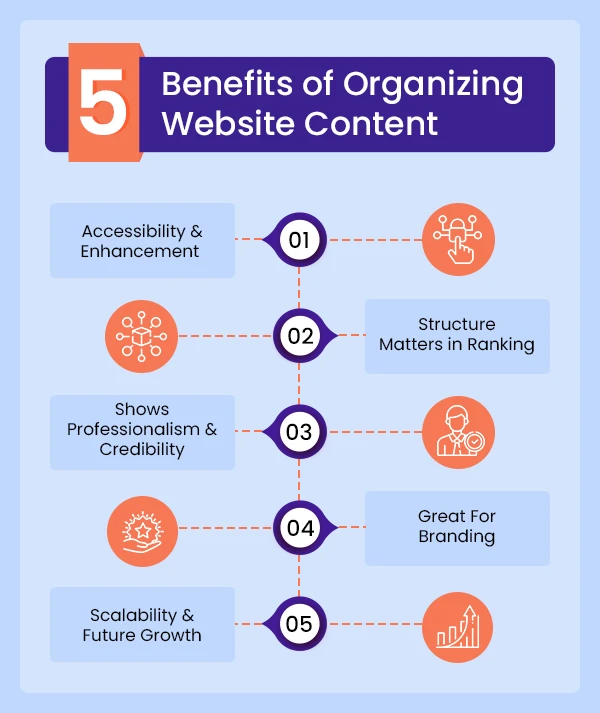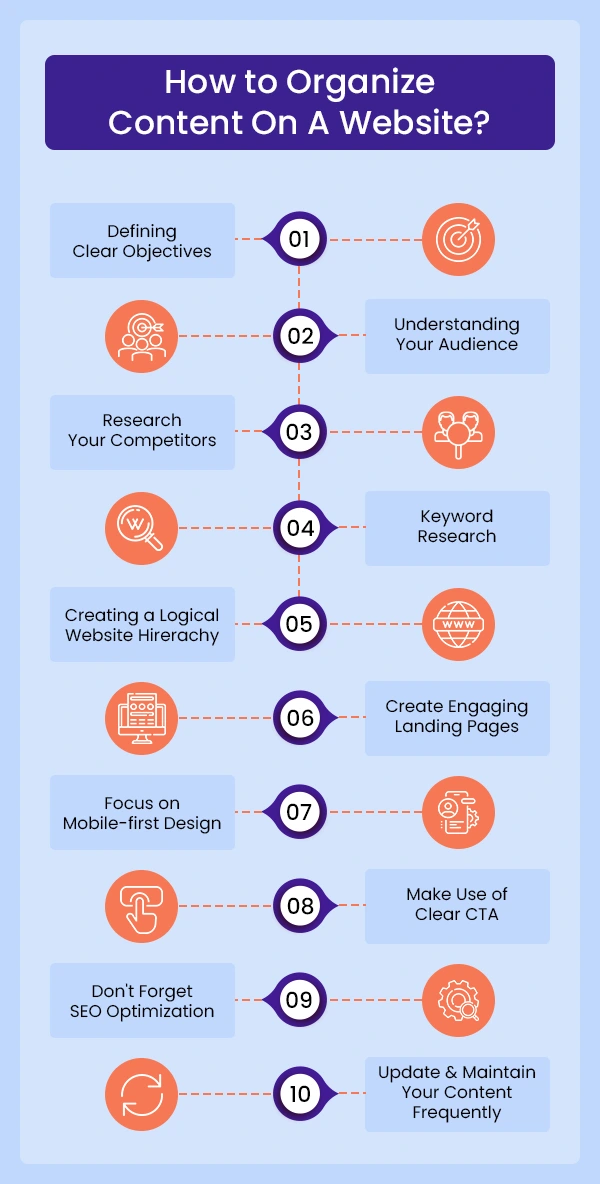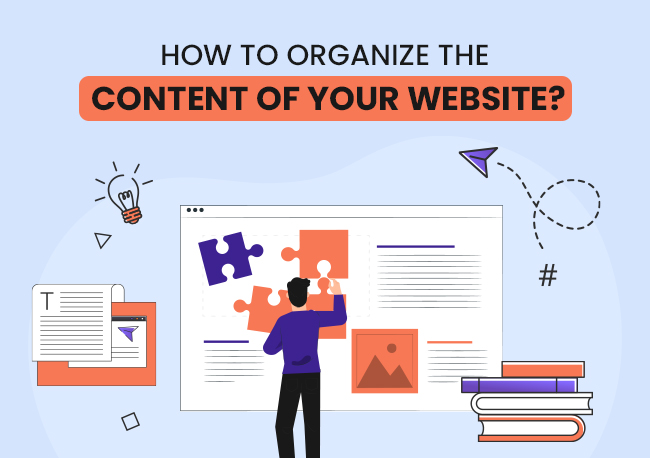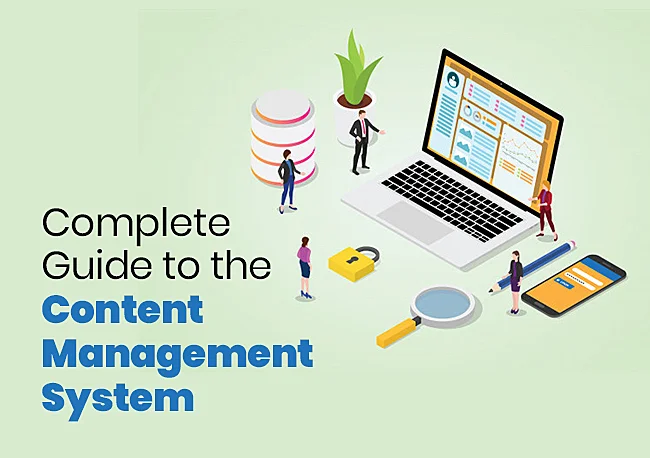“A place for everything, and everything in its place.”
This quote by Isabella Mary Beeton is the ideal representation of what we are about to convey through this write-up. Organizing – We all have heard about it and utilize it in everyday life to maintain a clutter-free environment and create a coherent system.
But did you know it is equally beneficial for your website’s content?
Besides being applicable to our physical environment, ‘organizing’ can also be implemented to store, categorize, and facilitate easy content retrieval.
This practice is vital for website owners and visitors alike. It enhances the user experience when they can navigate through your website seamlessly and acquire what they are looking for!
So, if you haven’t enforced this method, you are missing out on the opportunity to engage visitors and convert them into readers.
Read this blog as we guide you on how to organize website content.
What is Website Content Organization?
Website content organization indicates the process of structuring a website’s content into a chronological order for easy management, content retrieval, and usability.
Generally, this process involves categorizing content, labeling, and arranging it in a way that users can seamlessly browse and search engines can easily crawl and index a website.
Let us give you an example of website content organization.
Below is an example of how a typical service page of a salon website would look like –
- A banner with a tagline and hero text.
- Next, it will have an introduction about the services.
- The further section will include its services like hair cutting, washing, spa, waxing, pedicure, manicure, and more.
- Each service would include a description and price range.
- Lastly, it will have booking or appointment information with a click-bait CTA and contact details.
Since you have a comprehensive understanding of what is website content organization. Let’s move forward to the benefits of organizing content on the website.
Also Read: What Should You Consider When Developing Website Content?
Benefits of Organizing Website Content
1. Accessibility & Enhancement
Proper content organization can help your users find what they are looking for! They don’t have to search for specific pages on the website when it is arranged systematically. However, the content organization is not merely limited to intuitive navigation. The pages should be properly labeled, and if it has subcategories, those should be accurately named too.
Imagine this: You are on a beauty website with a category called ‘product’, and within it has multiple ‘subcategories’ such as mascara, eyeliner, foundation, and more.
Since the website has clearly classified its categories and subcategories, shoppers were able to find and buy the desired product, which enhanced their overall purchase experience.
2. Structure Matters in Ranking
We all know that search engines prioritize plagiarism-free content, the natural placement of keywords, and informative and quality content.
Did you know that they also consider the structure of your content?
According to Backlinko, Google’s search algorithm assesses over 200+ factors to rank a website at the top, one of which is the structure.
Google says, “our system also considers the usability of content. When all the things in content are relatively equal and accessible to users, it may perform better.”
Hence, ensure to emphasize all the aspects focused on by search engines to climb to the top in the SERPs.
Also Read: A Complete SEO Strategy Guide For New Websites
3. Shows Professionalism & Credibility
Your website content may have everything that ideal content should contain, such as keywords, relevant information, and detailed descriptions. However, if you have a sloppy layout, visitors will fail to perceive the information, resulting in unprofessionalism and a lack of credibility.
Therefore, keep your content organized and present your offerings effectively to boost credibility and customer retention.
Also Read: Top Industries That Can Benefit From SEO In 2023
4. Great For Branding
Can you recall any brand at the moment? If yes, kudos to them for making a remarkable impact, and cheers to your powerful memory. Have you thought about why you recalled that particular brand? what was so special about them? One of the reasons could be the cohesion.
Brands maintain a cohesive look by using similar fonts and colors and creating a structured layout. This ensures consistent branding and exhibits professional competence.
5. Scalability & Future Growth
A well-organized content structure allows you to seamlessly add or modify content in the future. Let’s assume you have a blogging website with 10,000 pages, and soon you will be adding more. If it does not have a proper structure, it will be challenging for you and your target audience to navigate through it.
Similarly, if your content is organized, you can offer seamless navigation and higher engagement. Furthermore, you can accommodate more content in the future without disrupting the user experience.
This was a quick rundown of the benefits. Let’s now walk you through the process of organizing a website’s content.
Let’s have a recap of what we learned about the benefits of organizing content on your website below:

Also Read: Can I Blog To Improve The SEO Of Website?
1. Defining Clear Objectives
Stating clear goals or objectives is the first step toward organizing website content. Generally, pages on a website are added for a reason.
For instance, a home page gives you a glimpse of the overall website, About Us delivers detailed information on the company, and a service/product page exhibits offerings.
You need to follow the same practice by clearly defining the purpose of each page on your website. We recommend you remove orphan pages from your website, if any. Orphan pages can be regarded as null and void as they are never indexed or crawled by search engines. Hence it would be best to eliminate them completely.
2. Understanding Your Audience
Organizing website content does not only entail you but also your users. Besides, you, your target audience, will be the ones scrolling through your website, and if they don’t have a good experience, the chances of them abandoning your website and never returning are high.
That’s why we recommend you follow a user-centric approach before structuring the content and layout. You first need to understand your target audience’s demographics, psychographics, and behavior. This will help you anticipate their requirements and present the content in an intuitive and logical manner.
Also Read: Difference Between Target Audience And Target Market
3. Research Your Competitors
Confused about how the content of a website is organized? Look around. Your competitors might already be acing it. Go through their websites, take a sneak peek into how they have presented their content, identify the content & navigation style they have used, and so on.
This will help you map out a unique and easy-to-use structure that will set your website apart from competitors, resulting in lead generation, conversions, and engagement.
4. Keyword Research
You might be wondering what keywords have to do with organizing content. Many might not know this, but keywords play a crucial role in creating cohesive website content.
Let’s explain it to you.
We all are familiar with the term “keywords.” They are basically long and short tail phrases searched by web users on search engines to acquire information on a topic.
Now, how they can help you form the structure of your content.
Simple!
Find primary and secondary keywords, as you would do for your content. You can include primary keywords or key phrases in your website’s content and present them as core offerings.
Whereas secondary keywords can be targeted in blogs, articles, or newsletters, which will be linked to your primary keywords or primary pages to build a logical connection, thereby boosting your rankings on search engines. For accurate keyword analysis and data, consider using APIs for search results to gather valuable insights and improve your strategy.
Also Read: Does Buying Traffic To Your Website Work?
5. Creating a Logical Website Hierarchy
Imagine this: You go to Google and search for “electric service providers near me.” The search results display a list of websites, and you click on any of the top-listed ones. Upon landing on the home page, you start searching for data and cabling services but can’t find the same, even if the website has the page.
So what would you do? Of course, head to another website offering the services you are looking for.
Problem: This situation generally occurs when a website has not listed its pages properly. Visitors may land on your website. However, if it does not contain the information the visitor searched for, they may abandon the website altogether.
Solution: The solution to this problem is pretty straightforward. Create a logical hierarchy of your website.
List down main topics and, if required, create subcategories. For instance – An online pet food website might offer different foods, like dry, wet, vegetarian, non-vegetarian, etc. Within the food category, you can create subcategories highlighting foods for dogs, cats, puppies, and similar.
You can also maintain the hierarchy through primary and secondary keywords, as we mentioned previously. You can draft supporting content, including blogs, articles, guides, etc. Internal linking can also be taken into account for building a bridge between the pages of your website.
Don’t forget to include a sitemap on your website. To give you an overview, a sitemap is a page of your website that highlights all the pages created on your website. Basically, you can discover a website’s information on this page, including overall website pages, videos, and other files.
This helps in providing seamless navigation and enhancing the overall user experience.
Also Read: Website Development Checklist To Help Create Your First Website
6. Create Engaging Landing Pages
The website does not solely rely on content but also on visuals and visual hierarchy. A mix of content and visuals strikes a balance in the web pages, leading to user engagement and increased interaction.
You need to draft compelling and clear content to grab the user’s attention right from the start. Additionally, you also need to focus on using high-quality and relevant visuals, including images, videos, infographics, etc., to support the content and message of your website.
Don’t miss out on adding a persuasive CTA and linking social proofs. Finally, all these elements should be in chronological order. You can utilize headings, subheadings, and bullet points to break up the content, making it easy for search engines and visitors to scan a webpage or website.
7. Mobile-first Design
We cannot stress enough on the importance of creating a mobile-first design. If you have a website, ensure it is responsive to every screen. Half of you readers might be wondering that most of your visitors are desktop users. However, this does not mean you will not optimize your website for mobile devices.
Your visitors can land on your website from any corner and device of the world. In fact, your existing visitors can access your website from a mobile device, and if it is not adjusted according to different screen sizes, the user experience will be disrupted.
Thus, mobile optimization is a must for uninterrupted and flawless site navigation.
Also Read: Best Content Management System Platform Optimized For SEO
8. Clear CTA
Download Now! Flat 50% Off! Sign Up Today! Book Now! We are sure you have seen such CTAs before. But why are they added to a website? Well, the idea is to encourage users to take the desired action. CTA exhibits a sense of urgency, prompting visitors not to miss out on the opportunity.
You might have also noticed that the CTA is always placed strategically around the relevant context. The aim is to reinforce visibility, accessibility, and convenience at every touch point.
Besides strategic and prominent placement, you also need to create a CTA that is clear, concise, and straightforward yet convincing. For instance – Subscribe Now, Tap to Get a Free Demo, Contact Now, Shop Now, See Now, etc.
9. SEO Optimization
You might be assuming that your job is over after drafting and organizing content, but no. All your efforts will be rewarded when you perform SEO optimization. You need to add relevant keywords in the content as well as headings, titles, subheadings, URLs, meta descriptions, and meta titles.
You also need to focus on internal linking, creating concise yet descriptive URLs, mobile optimization, and quick turnaround time. Prioritizing all these SEO factors will boost your rankings among search engines, displaying your content to the right audience.
Also Read: Does SSL Help SEO? Discover Eye-Opening Insights
10. Update & Maintain Your Content Frequently
Times change, and so do the requirements. So, why does the content on your website remain the same? You need to regularly update your content by staying up to date with the latest trends and demands of the users.
Furthermore, you also need to focus on upgrading the structure of your content according to the current scenario and demand of the market. This enhances user experience, makes your website look professional, and boosts your rankings on SERPs.
Let’s have a recap of what we learned about the process of organizing content on your website below:

Also Read: Website Optimization Tips To Increase Website Performance

Frequently Asked Questions
A typical website would include a header, navigation menu, content, CTA, and footer. All these aspects create a cohesive look and offer a user and browser-friendly experience.
Below are the most common mistakes that every website owner should avoid when organizing website content –
➔ Poor Navigation Structure
➔ No Chronological Order
➔ Cluttered Pages
➔ Inconsistent Formatting
➔ Lack of Search Functionality
➔ Overlooking Mobile Optimization
➔ Incomplete or Outdated Content
➔ Unclear CTA
Content hierarchy plays a crucial role in the website. It ensures easy navigation, seamless user comprehension, visibility on SERPs, and visual appeal while allowing you to arrange the content according to priority.
To maintain coherence throughout your website content, you can –
➔ Set styling guidelines
➔ Maintain branding consistency (logo, typography, colors)
➔ Use pre-designed layouts
➔ Establish content standards (word count, headings, subheadings, images)
➔ Carryout updates at regular intervals
➔ Conduct quality tests
Final Thoughts
We hope this blog helped you create a checklist of things you might be missing out on for organizing your website content. Lastly, stay consistent with the structure of your content. Doing so will help you scan, find, and retrieve important content, saving time and effort when searching for specific content.



